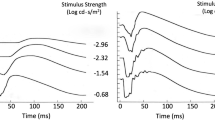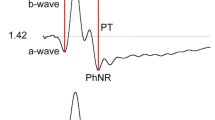Abstract
Dark-adapted electroretinogram (ERG) b-wave amplitudes and implicit times were recorded as a function of stimulus luminance for 15 retinitis pigmentosa (RP) patients and 15 normal subjects. B-wave amplitude as a function of log stimulus luminance was fit by non-linear regression with the Naka-Rushton equation, which has 3 independent parameters: The maximum response (Rmax), slope (n) and half-saturation constant (K). B-wave implicit-time as a function of log stimulus luminance was fit by linear regression. Compared to normal, the RP Rmax values were markedly reduced, suggesting response compression; the RP K values were elevated by an average of 0.76 log unit, suggesting relatively small losses in retinal sensitivity. There was no correspondence between Rmax and visual field area for the RP patients (coefficient of correlation = -0.02). All but 2 of the 15 RP patients had normal or shallower-than-normal implicit-time intensity-response functions, indicating that over most of the dynamic range of the ERG, the implicit-times were either normal or faster-than-normal. These results are discussed in terms of possible RP disease mechanisms.
Similar content being viewed by others
References
Armington JC, Gouras P, Tepas DI and Gunkel R (1961) Detection of the electroretinogram in retinitis pigmentosa. Exp Eye Res 1:74–80
Berson EL, Gouras P and Gunkel RD (1968) Rod responses in retinitis pigmentosa, dominantly inherited. Arch Ophthal 80:58–67
Berson EL, Gouras P, Gunkel RD and Myrianthopoulos NC (1969a) Dominant retinitis pigmentosa with reduced penetrance. Arch Ophthal 81:226–234
Berson EL, Gouras P, Gunkel RD and Myrianthopoulos NC (1969b) Rod and cone responses in sex-linked retinitis pigmentosa. Arch Ophthal 81:215–225
Berson EL and Kanters L (1970) Cone and rod responses in a family with recessively inherited retinitis pigmentosa. Arch Ophthal 84:288–297
Brunette JR and Lafond G (1978) Timing of the electroretinogram responses and dark adaptation. J Canad Sci Neurol 5:179–182
Draper NR and Smith H (1966) Applied regression analysis. New York, Wiley
Franceschetti A, François J and Babel J (1974) Chorioretinal heredodegenerations. Springfield, Thomas
Fulton AB and Rushton WAH (1978) The human rod ERG: Correlation with psychophysical responses in light and dark adaptation. Vision Res 18:793–800
Gouras P and Carr RR (1964) Electrophysiological studies in early retinitis pigmentosa. Arch Ophthal 72:104–110
Gouras P (1970) Electroretinography: Some basic principles. Invest Ophthal 9:557–569
Johnson MA and Massof RW (1982) The photomyoclonic reflex: An artefact in the clinical electroretinogram. Brit J Ophthal 66:368–378
Karpe G (1945) The basis of clinical electroretinography. Acta Ophthal Suppl 24:1–28
Krill AE (1972) Hereditary retinal and choroidal diseases, Vol I. New York, Harper and Row
Liu Y and Yang C (1966) Local and stray light components of the human electroretinogram due to stimulation by light subtending a 20° visual field. Scientia Sinica 15: 696–705
Massof RW and Finkelstein D (1979) Rod sensitivity relative to cone sensitivity in retinitis pigmentosa. Invest Ophthal Vis Sci 18:263–272
Massof RW and Johnson MA (1981) Prereceptor light absorption in setters with neuronal ceroid lipofuscinosis. Invest Ophthal Vis Sci 20:134–136
Massof RW and Finkelstein D (1981a) Two forms of autosomal dominant primary retinitis pigmentosa. Docum Ophthal 51:289–346
Massof RW and Finkelstein D (1981b) Subclassifications of retinitis pigmentosa from two-color scotopic static perimetry. Docum Ophthal Proc Ser 26:219–225
Naka KI and Rushton WAH (1966) S-potentials from colour units in the retina of fish (Cyprinidae). J Physiol 185:536–555
Rothberg D, Weinstein G, Hobson R and Nork T (1982) Electroretinography and retinitis pigmentosa. Arch Ophthal 100:1422–1426
Sandberg MA, Sullivan PL and Berson EL (1981) Temporal aspects of the dark-adapted A-wave in retinitis pigmentosa. Invest Ophthal Vis Sci 21:765–769
Author information
Authors and Affiliations
Additional information
Supported by research and core facility grants from the National Eye Institute (EY-01791 and EY-01765).
Research to Prevent Blindness, Foreign Scholar Fellowship recipient; from Capital Hospital, Chinese Academy of Medical Sciences, Beijing, Peoples Republic of China.
Rights and permissions
About this article
Cite this article
Massof, R.W., Wu, L., Finkelstein, D. et al. Properties of electroretinographic intensity-response functions in retinitis pigmentosa. Doc Ophthalmol 57, 279–296 (1984). https://doi.org/10.1007/BF00143087
Published:
Issue Date:
DOI: https://doi.org/10.1007/BF00143087




